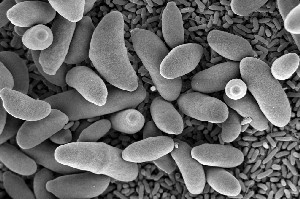Desulfotalea psychrophila

Classification
Bacteria; Proteobacteria; Deltaproteobacteria; Desulfobacterales; Desulfobulbaceae
Species
|
NCBI: Taxonomy |
Desulfotalea psychrophila
Description and Significance
Desulfotalea psychrophila is a gram-negative sulfate-reducing proteobacterium that is circular in shape and composed of a single chromosome approximately 3.5 million base pairs in length. The chromosome consists of two small plasmids and roughly 3100 predicted genes. The delta-proteobacterium is a marine organism which can be found in marine sediments that are permanently cold. This organism was first discovered in arctic marine sediment off the coast of Svalbard. Desulfotalea psychrophila can withstand extremely cold temperatures and can live in waters below 0°C. The organism does not form spores. The bacteria have respiratory and fermentative types of metabolism. Desulfotalea psychrophila is chemoorganotrophic. D. psychrophila has very little in common with other sulfate-reducing bacteria. The bacterium is strictly anaerobic. A photograph taken of the bacteria with an electron microscope reveals that D. psychrophila is rod-shaped in appearance, and some cells are sligtly curved. The organism breaks down sulfur as suggested by its name. D. psychrophila is believed to play an important role in energy cycles, as it is an abundant member of the microbial community. The bacterium plays an important role in energy cycles by contributing to global carbon and sulfur cycles. The organism functions at an increased rate in colder waters, which could mean the species may be an important player in prevention of global warming.
Genome Structure

The genome of Desulfotalea psychrophila strain LSv54 is one circular chromosome 3.523 million base pairs in length. The chromosome consists of two plasmids, 121 586 bp and 14 663 bp in length, along with 3118 predicted genes. D. psychrophila's genome was the first sequenced of any psychrophillic bacterium in 2004. Genome sequencing shows that Desulfotalea psychrophila is unique in that the microbe lacks homologues of several c-type cytochromes that are present in most sulfate-reducing lineages of the delta-proteobacteria.
Cell Structure, Metabolism and Life Cycle
Desulfotalea psychrophila has one polar flagella surrounded by a double membrane. The cells are large rods and vary in length, usually between 0.6 and 0.7 micrometers. The bacteria are chemoorganotrophs. Desulfotalea psychrophila has a respiratory and fermentative type of metabolism. The organism uses carboxylic acids, formate, alcohols, and amino acids as both carbon sources and electron donors. Sulfate, sulfite, thiosulfate , and ferric citrate are terminal electron acceptors and D. psychrophila reduces these to sulfide and ferrous citrate. Acetate is produced because of incomplete oxidation. Energy is obtained most effectively at temperatures between 10.0 and 18.0°C, however, the anaerobe is still able to grow in saltwater at temperatures as low as -1.8°C. The bacteria do not require vitamins for growth. The organism requires sodium chloride (10 g/L) and magnesium chloride for optimal growth.
Ecology and Pathogenesis
D. psychrophila is found in arctic marine sediments at permanently cold temperatures. Optimal growth occurs in temperatures between 10°C and 18°C and in pH levels between 7.2 and 7.9. Desulfotalea psychrophila requires magnesium chloride and sodium chloride for growth, and optimal growth occurs in at brackish or marine salt concentrations.
The species has biogeochemical significance in that it plays roles in the carbon and sulfur biogeochemical cycles. The bacteria may have contributions to the environment because the organism could be a major player in the prevention of global warming.
References
[1] 'KEGG Genome: Desulfotalea psychrophila', Kyoto Encyclopedia of Genes and Genomes. Desulfotalea psychrophila. 2004.
[2] Rabus, R. et al. 2004. The genome of Desulfotalea psychrophila, a sulfate-reducing bacterium from permanently cold Arctic sediments. Environmental Microbiology. 6(9)887-902
[3] Brenner, Don J., David H. Bergey, George M. Garrity, and Noel R. Krieg. "Genus V: Desulfotalea." Bergey's Manual of Systematic Bacteriology. 2nd ed. New York: Springer, 2005. 997-99. 26 Apr. 2009.
[4] BacMap: Bacterial Genome Atlas: Desulfotalea psychrophila.
[5] Brenner, Don J. "UniProtKB/Swiss-Prot Q6AJM7 (MURA_DESPS)." UniProt Knowledgebase. 2009. UniProt. 26 Apr. 2009.
Methé B, Nelson KE, and Fraser CM. 2004. It’s a cold world out there (but the prospects are hot). Microbial Genomics. 12(12):532-534
National Center for Biotechnology Information: NCBI
Author
Page authored by Joleen E. Manley and Jason E. Matthes, students of Prof. Jay Lennon at Michigan State University.

